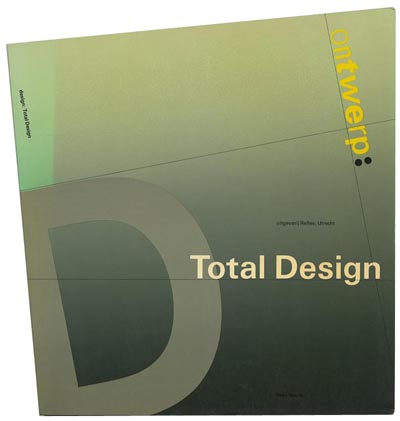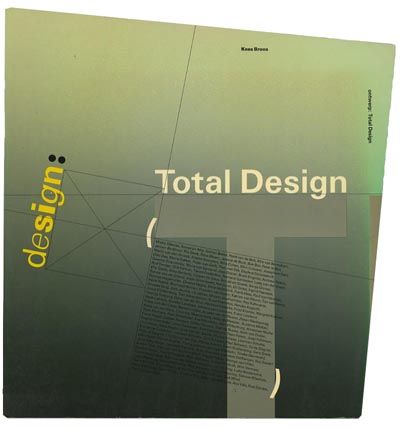ONTWERP: TOTAL DESIGN / DESIGN: TOTAL DESIGN
Kees Broos
Utrecht: Reflex in co-operation with Centre for Contemporary Art, Breda, 1983. First edition. Text in Dutch and English. Quarto? Printed wrappers. 96 pp. Fully illustrated in color and black and white. Elaborate graphic design throughout. Interior unmarked and very clean. Out-of-print. Wrappers with trivial wear, so a nearly fine copy of striking exhibition catalog.
10.25 x 10.75 [more or less since the book has a polygonal shape] soft cover book with 96 fully illustrated pages of work from the well known Dutch firm. Published in conjunction with an exhibition at the Centre for Contemporary Art, Breda. An incredible array of progressive design work including typography, trademarks and logos, letterhead, house-journals, newspapers and magazines, annual reports, graphics, encyclopedia, book covers, posters, calendars, stamps, signange and exhibitions.
Contents
- Preface
- 20 Years' Design: Total Design
- Design: Total Design
- Criticism and Discussion
- Bibliography
- Colophon
“It all began in 1963, when a number of designers teamed up to shape the world of tomorrow. Graphic, industrial and spatial design united in a strong belief in progress and functionalism: “design precision and directness, transparency and clarity, logic and rationalism” (Volkskrant, 1997). It was a completely new approach; and with it, Total Design and its founders Paul Schwarz, Dick Schwarz, Friso Kramer, Benno Wissing and Wim Crouwel, helped lay the foundations for the development of Dutch Design.” —Total Design
Willem Hendrik "Wim" Crouwel [The Netherlands, 1928 – 2019] was a celebrated twentieth century Dutch Graphic Designer and Typographer responsible for multiple iconic typefaces such as New Alphabet and Gridnik as well as his multidisciplinary work for Total Design.
Crouwel traveled extensively in Switzerland during the 1950s where he observed the emergence of the functional International Style. He returned to the Netherlands determined to alter the fundamental landscape of Dutch design. Crouwel was appointed the first general secretary of the International Council of Graphic Design Associations in 1963.
The same year Crouwel along with graphic designer Benno Wissing, Friso Kramer, Paul and Dick Schwarz, co-founded Total Design—the Netherlands’ first multidisciplinary design studio. The firm empowered Crouwel and his colleagues to influence the national and cultural identity of the Netherlands through their work. To that end Crouwel designed a wide variety of material, from postage stamps for the Dutch Post Office to an extensive body of work for the Stedelijk Museum.
“Wim Crouwel is one of the notable Dutch graphic designers of his generation. In his leading role in the firm of Total Design (hereafter ‘TD’), from its foundation in 1963 through to the 1980s, Crouwel worked at the heart of Dutch design in the years when this phenomenon began to crystallize and to gain international recognition. If one applies the test of design for the national airline, it may be some measure of Dutch cultural reticence that around the time of the sharp upswing in the post-1945 prosperity – from 1958 – the new identity for KLM (‘Royal Dutch Airlines’) was designed at F.H.K. Henrion’s studio in London; but soon such jobs would go to TD. For example, from the mid-1960s this young firm was at work on the signing for Amsterdam’s Schiphol Airport (designed by a group under the direction of partner Benno Wissing), and thus TD’s lowercase-only sanserif typography contributed to the first impressions of the country for anyone flying in. (The calm interiors at Schiphol – still surviving, although the signs are now being replaced – were designed by Kho Lang Ie, with whom Crouwel had worked in partnership in the 1950s.) And from 1963, after the retirement of Willem Sandberg and the accession of Edy de Wilde, Crouwel and TD became designers to Amsterdam’s Stedelijk Museum: both a local municipal institution and by then an important component of the international art scene . . . .
“By the 1970s, TD seemed to be acting out all the meanings of its title, not just the ‘cross-disciplinary’ implication. From early on in his career, as part of his own ‘total’ approach to his profession, Wim Crouwel has sat on committees and juries, delivered addresses and lectures, written articles, and held academic positions (notably at the Technische Hogeschool Delft). This tireless public work reached its apex in 1985 when he took up the directorship of the the Boymans van Beuningen Museum in Rotterdam.
“In 1993, aged 65, Wim Crouwel retired from his position at the Boymans Museum. In advance of this, early in 1990, Frederike Huygen, then curator of design in that museum, began to make plans to write and produce a book about Crouwel. It would mark his retirement, not with a simple celebration, but rather with a sophisticated and critical discussion. It is remarkable that Wim Crouwel should have put himself and his archive – then acquired by the Stedelijk Museum Amsterdam – at the disposal of the researchers, with no strings attached, no attempt by him to interfere or control: this unusual willingness to become the subject of a critical experiment helps to explain the nature of the book that was finally made. —Robin Kinross


 Updating...
Updating...